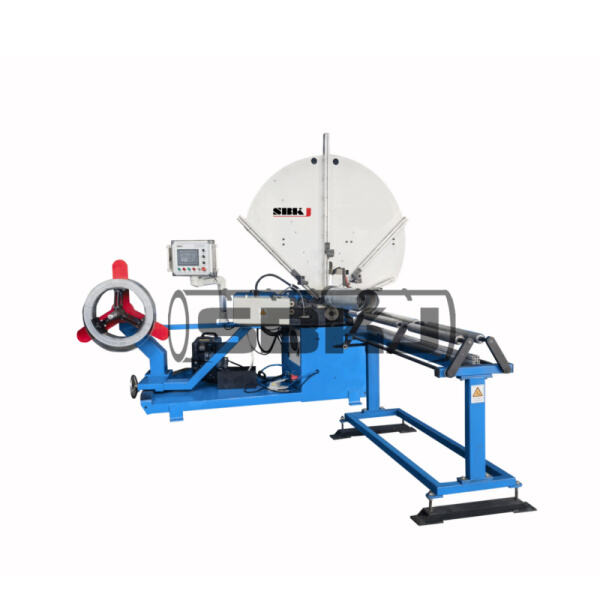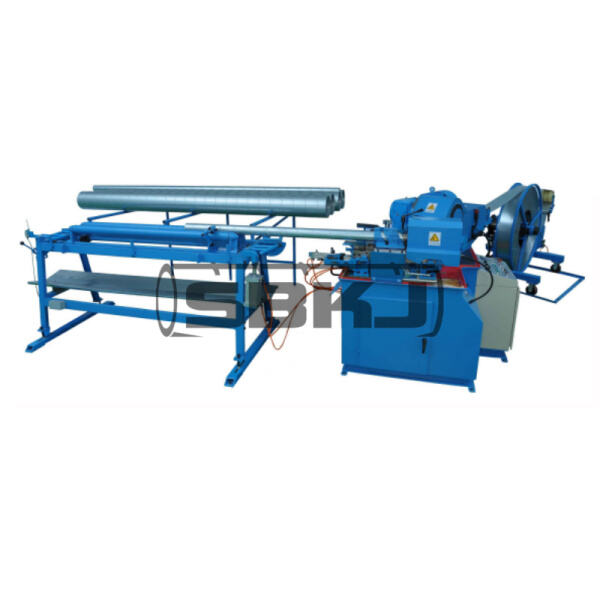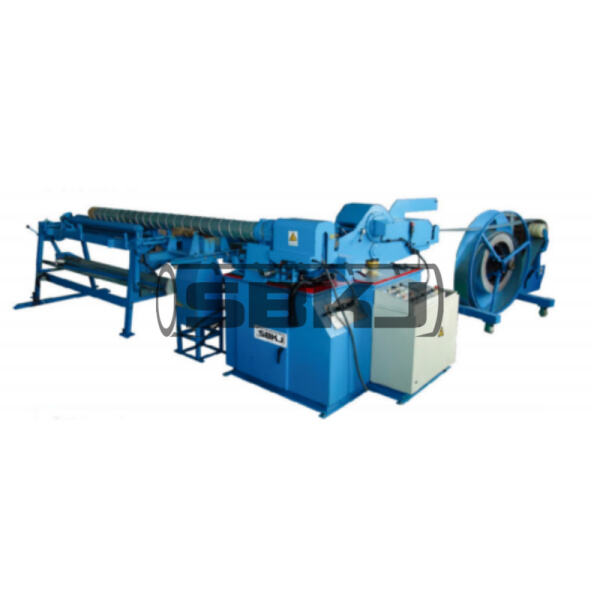যদি আপনি কখনও আপনার ছাদের দিকে তাকিয়েছেন বা আপনার ঘর বা অফিসে ভেন্টস লক্ষ্য করেছেন, তবে সম্ভবত আপনি ডাক্টিং নামের একটি জিনিস দেখেছেন। ডাক্টিং হল একটি পথ ব্যবস্থা যা একটি ভবনে বাতাস চলাচ্ছুটির জন্য ব্যবহৃত হয়। বাস্তবে, এটি HVAC ব্যবস্থার একটি প্রধান উপাদান। HVAC এর অর্থ হল হিটিং, ভেন্টিলেশন এবং এয়ার কন্ডিশনিং। এই নিবন্ধে, আমরা ডাক্টিংের মৌলিক বিষয়গুলি আলোচনা করব। আমরা বুঝতে চেষ্টা করব ঘরে ডাক্টিং ইনস্টলেশনের মূল ধারণা, বাণিজ্যিক ভবনে ব্যাপক ডিজাইনের জন্য কিছু ডিজাইন আইডিয়া, ভালো ডাক্টিংের গুরুত্ব এবং রিস এবং ব্লকেজ এমন সমস্যাগুলি খুঁজে বের করার এবং সমাধান করার উপায়। SBKJ Spiral Tubeformer স্পায়ারাল ডাক্টিং এবং স্পায়ারাল টিউবফর্মারে বিশেষজ্ঞ, যা যদি আপনি মানসম্পন্ন ডাক্টিং সমাধান চান তবে এটি আদর্শ পছন্দ হবে।
ডাক্টিং হলো HVAC সিস্টেমের একটি গুরুত্বপূর্ণ উপাদান। ডাক্টিং সিস্টেম এক জায়গা থেকে আরেক জায়গায় বাতাস পরিবহনের জন্য ব্যবহৃত হয়। ডাক্টিং-এর অনেক ধরণ এবং আকৃতি রয়েছে। আপনি যে ধরণের ডাক্টিং ব্যবহার করবেন, তা ভবনের উপর নির্ভর করবে এবং আপনি যে এয়ার কন্ডিশনিং এবং হিটিং সিস্টেম ব্যবহার করেন তার উপরও নির্ভর করবে। আয়তাকার হলো ডাক্টিং-এর একটি সাধারণ আকৃতি। ঘরে এটি সাধারণত ব্যবহৃত হয় এবং এটি দেওয়াল এবং ছাদের মধ্যে সঙ্গে সঙ্গে সরু জায়গায় ফিট হওয়ার জন্য ডিজাইন করা হয়। গোলাকার ডাক্টিং হলো অন্য একটি সাধারণ ধরণ এবং এটি বড় বাণিজ্যিক ভবনে অনেক সময় ব্যবহৃত হয় কারণ এটি বেশি পরিমাণের বাতাস বহন করতে পারে। এটি খুবই গুরুত্বপূর্ণ যে আপনি আপনার HVAC সিস্টেমের জন্য সঠিক ধরণের ডাক্টিং নির্বাচন করেন। এই বিকল্পটি আপনাকে নিশ্চিত করবে যে আপনার বাসস্থানে সেরা এয়ার কন্ডিশনিং এবং বেন্টিলেশন পাচ্ছেন।
ঘরে ডাক্টিং ইনস্টল করার সময় কিছু গুরুত্বপূর্ণ বিষয় বিবেচনা করা উচিত। প্রথমত, ডাক্টিং-এর আকারটি অত্যন্ত গুরুত্বপূর্ণ। এটি আপনার ঘরের আকার অনুযায়ী নির্বাচন করতে হবে। ছোট আকারের ডাক্টিং ব্যবহার করলে বায়ু প্রবাহে সীমাবদ্ধতা ঘটতে পারে, অপরদিকে বড় আকারের ডাক্টিং অপরিদর্শিতভাবে কাজ করতে পারে। দ্বিতীয়ত, ডাক্টিং-এর উপাদান আপনার ইনস্টল করা HVAC সিস্টেমের সাথে একই হওয়া উচিত। ভিন্ন উপাদানের ভিন্ন তাপমাত্রা বৈশিষ্ট্য বায়ু প্রবাহের কার্যকারিতাকে প্রভাবিত করে। তৃতীয়ত, ডাক্টিং-এর জন্য বিপরীত উষ্ণতা হার কমানোর জন্য এটি ব্যবহার করা উচিত (যা কোন অবস্থায় ভালো বিচার)। এই গঠনটি তাপ হারকে কমিয়ে দেয় এবং সিস্টেমটি অপটিমালি কাজ করতে সমর্থ করে। শেষ কথা, ডাক্টিং ইনস্টল করার জন্য একজন পেশাদার ব্যক্তির প্রয়োজন। একজন বিশেষজ্ঞ ইনস্টলারের সাথে কাজ করা যেন সব ধাপ সঠিকভাবে সম্পন্ন হয়। এই সহজ পদক্ষেপগুলি অবলম্বন করে আপনি আপনার HVAC সিস্টেমের কাজ করছে এবং দক্ষতার সাথে কাজ করছে তা নিশ্চিত করতে পারেন।

যখন এটি HVAC সিস্টেমের কথা আসে, বাণিজ্যিক ভবন অবিশ্বাস্যভাবে জটিল হতে পারে। এগুলিতে বিভিন্ন অঞ্চল এবং বিভিন্ন ধরণের বায়ু প্রবাহ রয়েছে যা নিয়ন্ত্রণ করা উচিত। সমস্ত বাণিজ্যিক বিল্ডিং নল নকশা দক্ষতা উপর দৃষ্টি নিবদ্ধ করা উচিত। আপনার সিস্টেমের জন্য সঠিক ফ্যান নির্বাচন করা একটি ভাল টিপ। ভ্যানগুলি এইচভিএসি সিস্টেমের অপরিহার্য উপাদান এবং অনুপযুক্ত ভ্যান নির্বাচন অতিরিক্ত শব্দ বা সিস্টেমের অকার্যকর অপারেশনের ফলে হতে পারে। এর মধ্যে একটি নলকে যতটা সম্ভব কম বাঁক দিয়ে সংক্ষিপ্ত রাখা অন্তর্ভুক্ত। দীর্ঘ সময় ধরে নল বা অত্যধিক বাঁকগুলি প্রতিরোধ গড়ে তুলতে পারে, যা সিস্টেমের মাধ্যমে বায়ু প্রবাহকে আরও কঠিন করে তোলে। আপনার বিল্ডিংয়ে গরম বা ঠান্ডা স্পট, অভ্যন্তরীণ বায়ুর গুণমানের দুর্বলতা এবং প্রচুর অতিরিক্ত শক্তি ব্যবহারের মতো সমস্যা এড়াতে সঠিক নল নকশা অত্যন্ত গুরুত্বপূর্ণ।

ঠিকভাবে ইনস্টল করা ডাক্টিং-এর ফায়দা অনেক। প্রধান সুবিধা হলো ভিতরের বায়ুর মান ভালো হওয়া। ঠিকমতো ডাক্ট ইনস্টলেশন ভিতরের দূষণকারী জিনিস, যেমন ধুলো, পোলেন এবং মোল্ড কমাতে পারে। এটি অর্থহীন যে, আপনি যে বায়ু ঘরে বা ভবনে শ্বাস গ্রহণ করেন তা পরিষ্কার এবং স্বাস্থ্যকর হতে পারে। এছাড়াও বিদ্যুৎ বিল কমে। ঠিকভাবে ইনস্টল করা HVAC ডাক্টিং এইচভিএসি সিস্টেমকে আরও ভালোভাবে চালু করে, যা ফলে বিদ্যুৎ ব্যয়ের উপর বড় সঞ্চয় হয়। গাদ়া দ্বারা ব্লক না হওয়া ডাক্টিং-এর জন্য এটি কম পরিস্কার এবং রক্ষণাবেক্ষণের প্রয়োজন হয়। এটি আপনাকে প্রrepair বিল সঞ্চয় করতে দেয় এবং আপনার HVAC ইউনিট আরও দীর্ঘকাল ভালোভাবে কাজ করতে দেয়।

সীমিত বা রিসিং ডাক্টিং কম বায়ুপ্রবাহের কারণ হতে পারে এবং ফলে আরও বেশি শক্তির খরচ হতে পারে। যদি আপনি আপনার ডাক্টিং-এ ব্লক বা রিস লক্ষ্য করেন, তবে সমস্যাটি সম্ভবত সমাধান করতে হবে। একটি ডাক্ট পরীক্ষা যন্ত্র বা ধোঁয়ার মशीন ব্যবহার করে রিস বা ব্লকেজ চিহ্নিত করা যেতে পারে। এই যন্ত্রগুলি আপনাকে বুঝতে সাহায্য করবে যে কোথায় বায়ু রিস হচ্ছে। যদি আপনার এই যন্ত্রগুলি না থাকে, তবে আপনি একটি সহজ পদক্ষেপ গ্রহণ করতে পারেন। আপনার ডাক্টিং-এর সমস্ত দৈর্ঘ্য অতিক্রম করুন এবং দেখুন কোথায় বায়ুপ্রবাহ চলছে না বা পালিয়ে যাচ্ছে। সমস্যা চিহ্নিত করার পর, সমাধানটি সহজ হতে পারে। এটি সাধারণত ডাক্টিং উপকরণ সংশোধন বা ক্ষতিগ্রস্ত অংশটি প্রতিস্থাপন করা বোঝায়।
আমরা প্রতিজন গ্রাহকের জন্য একজন নির্দিষ্ট গ্রাহক সেবা প্রতিনিধি এবং এফটার-সেলস সেবার জন্য একটি নির্দিষ্ট হটলাইন এবং এফটার-সেলস ওয়েচাইট গ্রুপ নিয়োজিত করি। আপনি আমাদের অনলাইনে সহজেই খুঁজে পেতে পারেন। ইন্টারনেটের সাহায্যে আমরা আপনাকে দ্রুত সাহায্য করতে এবং সমস্যা সমাধানে সহায়তা করতে পারি। SBKJ এর উপকরণ এক বছরের গ্যারান্টি এবং জীবনব্যাপী পেইড মেন্টেন্যান্স দ্বারা আবদ্ধ।
বছরের পর বছর SBKJ স্পায়ারেল ডাক্ট তৈরি শিল্পের একজন নেতা ছিল। তাদের কয়েকটি পেটেন্ট রয়েছে, যেমন ফ্লাইইং সিলিটার, ফ্লাইইং ক্রিন্পার এবং ফ্লাইইং টেটার। SBKJ-এর গবেষণা এবং উন্নয়ন আমরা যে টিউবফর্মার ব্যবহার করি তার ভিত্তি তৈরি করেছে, যা উচ্চ গুণবত্তা সহ কম খরচে DUCTING উৎপাদন করতে পারে।
DUCTING চীনের যাংটসে রিভার ডেলটায় অবস্থিত, শাংহাইর কাছে। SBKJ একটি স্পায়ারেল টিউবফর্মার তৈরি করে যার অভিজ্ঞতা ৩০ বছরেরও বেশি। SBKJ-এর স্পায়ারেল টিউবগুলি DIN, BS Euroorm এবং Smacna মানের সাথে মেলে। আমাদের গ্রাহকরা বিশ্বব্যাপী ৬০টিরও বেশি দেশ থেকে আসে।
SBKJ OEM সেবা প্রদান করে। আপনি আপনার ডিভাইস থেকে SBKJ লোগো সরাতে পারেন বা আপনার ডিভাইসের জন্য আঠালো রঙ চাওয়া যেতে পারে। আপনি প্রোগ্রামের ভাষা নির্বাচন করতে পারেন, যদি আপনি DUCTING অনুবাদ করে থাকেন। আমরা আপনার উৎপাদনের প্রয়োজন অনুযায়ী আপনার সরঞ্জাম আঠালো করতে পারি।